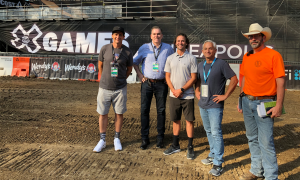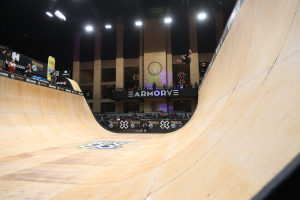Live From X Games Minneapolis: Tech-Loaded Show Promises ‘More Skating, Less Waiting’
A mobile host studio, a Technocrane, and a halfpipe in a concert venue among ESPN’s efforts
Story Highlights
Slow. Small. Boring.
Words one would never associate with the spectacle that is the X Games.
And the teams at ESPN and Echo Entertainment aim to ensure that is true of each edition of the crown jewel of action sports events. Their goal: build a show that’s faster, bigger, and more exciting than ever.
For years, X Games has pushed the envelope not just for what’s possible with its athletes on the track or the halfpipe but also for sports-video production and technology. This year, Minneapolis’s U.S. Bank Stadium will be packed with cutting-edge cameras, unique technology deployments powered by an ocean of RF, and a robust audio and comms plan that will power approximately 18 hours of live linear content over the event’s four days.
New ‘Jam Formats’ Tighten Up Competition, Coverage
One might think it would be hard to find dead spots in live X Games programming, but leave it to ESPN VP, X Games, Tim Reed and his team to find and target them.

The teams from ESPN and Echo Entertainment developed a massive production plan for X Games: (from left) ESPN VP, X Games, Tim Reed; SVP, Programming and Acquisitions, Rob Temple; and Director, Content Strategy, X Games, Jason Krutzsch; Echo Entertainment President Hugh Arian and Technical Producer Pierce Williams.
According to Reed, one of the challenges the team wanted to combat in this year’s event is the broadcast time spent waiting for judges’ scores to be delivered. As a result, X Games is introducing what it is calling “jam formats” on selected clock-based events (like Vert and Park). In these, judges will wait to officially score at the end of a series of runs.
“We like to call it more skating, less waiting,” says Hugh Arian, president, Echo Entertainment, ESPN’s longtime production partner on everything X Games. “Judges need to do their jobs, but, sometimes, we’re waiting 60 seconds for a score after a run. We can just get more competition in. It speaks to entertaining the viewing habits of the youth of today.”
Adds Reed, “We’re trying to add even more action into our broadcasts. We’ve also seen the research that people really want to see the tricks and action and aren’t concerned so much with the score. So we’re trying to leverage what we’ve seen in the research to see if it creates more engagement on the broadcast side.”
Mobile Host Set Leads Heavy RF Effort
A major alteration in this year’s show plan — compared with the previous two times the event has been here in Minneapolis — is the lack of a physical host set in the venue. In one year, a set was built on a tower in the main bowl; in the other, on the main concourse at the stadium’s north entrance. This year, instead of having a dedicated home for its host and talent, the hosts will move around the building, with segments taking place all around the stadium.
“This year, we want to pull the curtain back a little bit,” says Arian. “The goal is to get places that we’ve never been before, like the athletes lounge and in the pits with the motorcycles. It’ll really help keep the pace up. I think, when we have the host set, which we enjoy, there’s maybe a mindset that we have to spend more time there because we went through the trouble of building it. We’re going to try to make our host-set executions just a little bit shorter.”
It will take a heavy load of RF to make that mobility possible. Two RF cameras will follow the roaming host set wherever it goes. BSI is here in force, with extra RF mics, IFBs, cameras, and more to support. Operations also needed to install many more receive sites around the building to enable the mobility of the RF technology powering the “studio host.”
Cameras: Nimble, Robotic, High-Speed, Plentiful
It also wouldn’t be X Games without an impressive camera arsenal ranging from the beefiest of high-speeds to the tiniest of Antelope Picos.
According to Pierce Williams, technical producer, Echo Entertainment, a total of 55 cameras are deployed in the stadium. He estimates that, with the benefit of RF and the ability to reposition smaller robotics, the show will use more than 125 unique camera positions throughout the weekend.
ESPN and Echo have deployed a base of about 35 Sony HDC-2400’s to handle the primary acquisition load. Meanwhile, a sea of specialties will add color to the proceedings: five Sony HDC-4300’s will offer super-slow-motion imagery, Spidercam will deliver aerial coverage, and four robotic cameras will provide scenic shots.
There are five Marshall POV cameras, and four RF POVs feature proprietary technology built by BSI specifically for X Games. Williams says they give great views of events like Flat Track, Moto, and BMX.
The X Games crew has fallen in love over the years with Antelope Pico cameras from Polecam. Small and compact, they can be quickly dropped and mounted to various tracks around the stadium. Plus, they shoot at 350 fps.
A 50-ft. Technocrane is also here to cover its very first Summer X Games, as is the popular Pylon Cam, which ESPN uses on Monday Night Football and major college football games.
Deeper Blending of Music and Sports
A new wrinkle in this year’s event is that selected halfpipe events will actually be taking place in the nearby Armory. The historic Downtown Minneapolis concert venue typically hosts numerous musical performances during X Games weekend, but ESPN and Echo decided to lean in even further on the aspect of X Games where sports and music collide, installing a Vert Ramp adjacent to the concert stage.

For the first time, competitions will take place inside The Armory, a historic venue that typically houses concerts throughout X Games weekend.
With televised activities not starting inside U.S. Bank Stadium until Friday, Reed and the team thought this was a great way to give Thursday the juice that opening night deserved.
“The [venue] was a really big driver,” says Reed. “It’s such a cool space. We feel it helps upgrade our Vert event and gives our Thursday night more impact.”
Because The Armory is about 2½ blocks from U.S. Bank Stadium, instead of parking a mobile unit outside it, Williams and his team ran 36 lines of dark fiber more than 9,000 ft. to connect The Armory to the main compound outside the stadium.
In the Compound
With the addition of an Apex Legends esports stage at U.S. Bank Stadium, this year’s X Games production compound expands to house six trucks, including Dome Productions’ 4K-capable VISTA unit, which will be producing live Apex Legends esports shows for distribution to Twitch in 1080p.
Five of the trucks in the compound are courtesy of Dome: Journey, Pacific, and Silver are here, along with an expando B unit housing communications, robo camera ops, and a MADI router. An extra truck in the compound houses a BSI control center for the large complement of RF cameras and comms.
According to Williams, one of the most notable advantages of hosting the X Games at U.S. Bank Stadium is its state-of-the-art and efficient internal fiber network. Even so, ESPN still brought in some of its own tech talent to oversee fiber and run an additional 60,000 ft.
The broadcaster has eight transmission paths leaving the venue and going to Bristol for final distribution to linear. Four paths are satellite; the other four are fiber.
Robust Audio and Comms Efforts
Sure, the X Games event offers stunning visuals of athletes pulling off spectacular tricks or getting serious air, but it’s the clapping of the skateboards, the riff of a guitar, and the roar of the crowd that make the experience truly immersive. This year’s production, which is available in discrete 5.1 surround sound, will feature more than 350 individual microphones scattered across the various events and interconnected by Andiamo MADI and Calrec Hydra.
On the comms end, there is a trunked system between the three primarily production trucks in the compound that incorporate the in-house system. With as many as 100 unique users in the comms pick sheet, the crew will have the flexibility to decide whom they want to communicate with and when.
A trunked repeater system features 14 repeaters. More than 1,200 radios and 800 speaker mics will be used at these X Games, with 95 radio channels supporting various production and operations teams throughout the venue.
